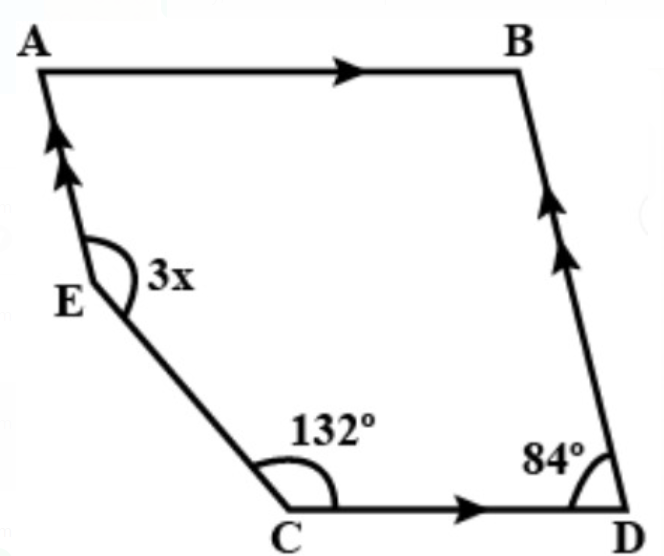In Fig.101, ABCD and EF is a transversal. The value of y−x is (a) 30 (b) 35 (c) 95 (d) 25
To solve the problem step by step, we will use the properties of parallel lines and transversals.
Step 1: Identify the Corresponding Angles
Since lines AB and CD are parallel and EF is a transversal, we know that the angles formed at the intersection of the transversal with the parallel lines are corresponding angles. Therefore, we can say:
Angle P=Angle Q
Step 2: Set Up the Equation
From the problem, we have:
- Angle P = 5x−20
- Angle Q = 3x+40
Since Angle P is equal to Angle Q, we can set up the equation:
5x−20=3x+40
Step 3: Solve for x
Now, we will solve the equation for x:
1. Subtract 3x from both sides:
5x−3x−20=40
2x−20=40
2. Add 20 to both sides:
2x=60
3. Divide by 2:
x=30
Step 4: Find Angle P
Now that we have x, we can find Angle P:
Angle P=5x−20
Substituting x=30:
Angle P=5(30)−20=150−20=130
Step 5: Find Angle y
Since Angle P is equal to 2y (as they are vertically opposite angles), we can set up the equation:
2y=130
Now, solve for y:
1. Divide by 2:
y=1302=65
Step 6: Calculate y - x
Finally, we need to find y−x:
y−x=65−30=35
Conclusion
The value of y−x is 35. Thus, the correct answer is option (b) 35.
---
Since lines AB and CD are parallel and EF is a transversal, we know that the angles formed at the intersection of the transversal with the parallel lines are corresponding angles. Therefore, we can say:
Angle P=Angle Q
From the problem, we have:
- Angle P = 5x−20
- Angle Q = 3x+40
5x−20=3x+40
Now, we will solve the equation for x:
1. Subtract 3x from both sides:
5x−3x−20=40
2x−20=40
2x=60
x=30
Now that we have x, we can find Angle P:
Angle P=5x−20
Substituting x=30:
Angle P=5(30)−20=150−20=130
Since Angle P is equal to 2y (as they are vertically opposite angles), we can set up the equation:
2y=130
1. Divide by 2:
y=1302=65
Finally, we need to find y−x:
y−x=65−30=35
The value of y−x is 35. Thus, the correct answer is option (b) 35.
Topper's Solved these Questions
Similar Questions
In Fig.95, If AB, CD and EF are straight lines, then x= (a) 5 (b) 10 (c) 20 (d) 30
View SolutionIn Fig.85, AB||CD and AC||BD. Find the value of x,y,z.
View SolutionIn Fig.72, if AB∣∣CD and AE∣∣BD, then the value of x
 is
(a) 38 (b) 48
(b) 58 (d) 68
is
(a) 38 (b) 48
(b) 58 (d) 68
View SolutionIn Fig.96, If AB, CD and EF are straight lines, then x+y+z= (a) 180 (b) 203 (c) 213 (v) 134
View SolutionIn Fig.100, AB∣∣CD and EF is a transversal intersecting AB and CD at P and Q respectively. The measure of ∠DQP is (a) 65 (b) 25 (c) 115 (d) 105
View SolutionIn Fig.73, the value of x is 20 (b) 30 40 (d) 25
View SolutionIn Figure, AB∣∣CD and ∠F=30∘ . Find ∠ECD.
View SolutionIn Figure ABCD and AEFD are two parallelograms. Prove that: PE=FQ
View SolutionIn Fig.102, ABCDEF, ∠ABG=1100,∠GCD=1000 and ∠BGC=x0. the value of x is (a) 35 (b) 50 (c) 30 (d) 40
View SolutionIn the given figure, if AB∣∣CD , the value of x is
(a) 25
(b) 35
(c) 15
(d) 20
View Solution
